It was about this time of year in 2021 that Coffee Magazine adventured to Namibia to learn all about Slowtown Coffee Company as they celebrated their 10th year in business and got treated to a phenomenal adventure through the wilds of this spectacular travel destination.
Words by Iain Evans
Endemic / (of a plant or animal) native and restricted to a certain place.
A lifer, for any nature enthusiast or birder, is the first time you see a species and tick it off your list. For many who fall into this category it is the addiction of planning the next outing or great adventure in the hope of spotting the next lifer and feeding the ever-growing list!
.png)
Start your day with a delicious breakfast and well made Slowtown Coffee at Strand Hotel in Swakopmund before heading off on adventures!
It is a little like planning a trip to a new city or a new country where the allure of unexplored coffee spots, baristas, beans and brews, has you ready to add them to your all-time list, snap them to Instagram and share them with your jealous friends back home. So you can imagine my excitement, standing in the sand dunes of the Namib desert, the impossibly blue sky above us, as Chris Nel, owner and founder of Living Desert Adventures, digs with his bare hands, a tunnel into the dune to unearth the elusive web-footed gecko.
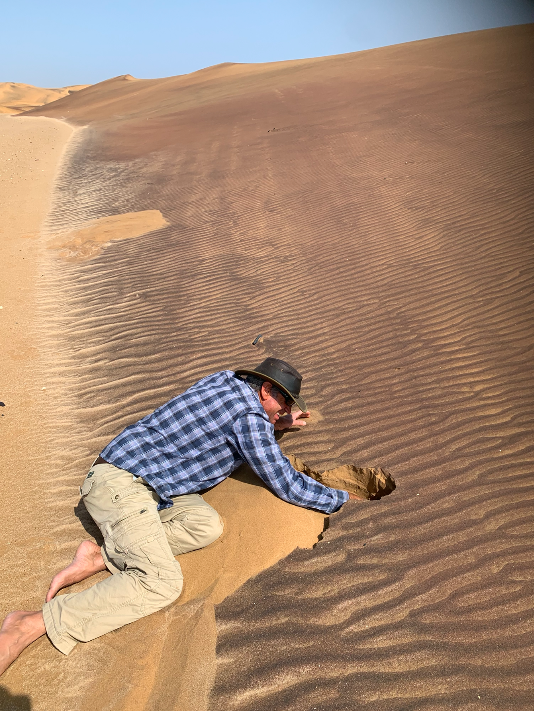
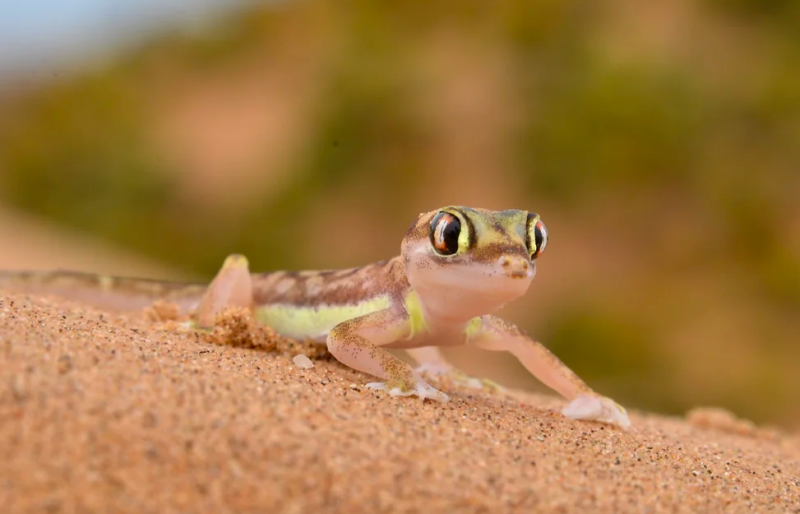
“At first, you just see sand. It can seem a little bit surreal. But after a couple of days of being here you see the desert is alive. Then you see its beauty and you will never forget it for as long as you live.”
It doesn’t seem possible, the sand seems so all-consuming, sucking the moisture off the sea out the air. Yet this delicate eco-system is home to 200 species of beetle, 40 species of fishmoth, ants, termites, geckos, chameleons, lizards, skinks, spiders, crickets, snakes, hares, falcons and jackals. Chris’ mission is to educate visitors like me to the life and the beauty of the desert, and to fight for its protection.
Chris drives further into the dunes, where the colours of the sand begin to change. “The dune colours are yellow, white, red and black” he explains. The yellow is young quartz, coarse like coffee grounds for a plunger. The white sand is also quartz, but old and hence ground fine like espresso, from the burrs of wind and time. The red is garnet, and the fine grounds give the dunes a pinky purple hue, that is rather magical. And the black is from iron oxide, a naturally occurring magnetite (FE304), which Chris demonstrates by extracting from the desert floor with a magnet. A very effective tour trick, simple but so completely effective. I could’ve stayed making iron hedgehogs with that magnet all day!
I feel extremely overwhelmed on the drive back to Swakopmond. The vastness of the desert, the mindboggling factoids that Chris had dropped on me for the last 4 hours and the sheer uniqueness of flora and fauna that have survived for millions of years in this little sliver of dunebelt between Walvis Bay and Swakopmund and grateful for people like Chris who have both opened my mind and heart to this completely and uniquely beautiful biome.
The little Five :
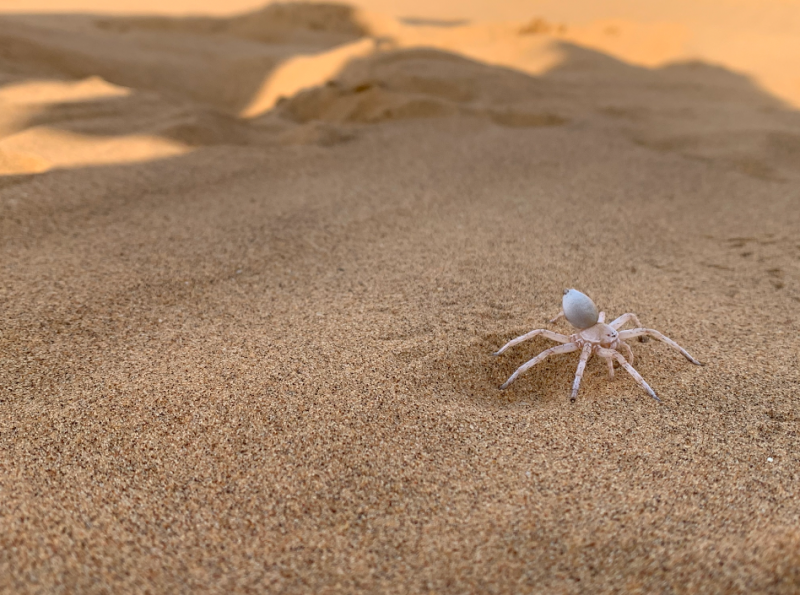
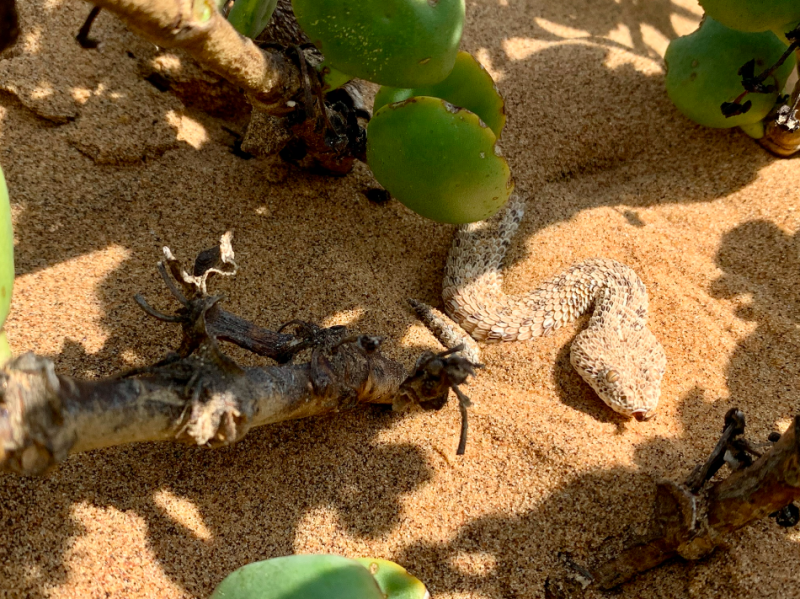
The day before under moody contrasting moody skies I had seen the dunes by bike. Fat Bike to be exact. What a unique way to explore the dunes. This is also one of the least destructive ways to do this, which was quite a sobering fact to learn.

Because of the fascinating ways the dune system works, in certain places in the valleys between the dunes on the more stony ground, if you leave a trail, it lasts forever. On the sand though, the wind grooms the dunes clean and fresh taking the traces we leave with them. This means that barreling down a dune on a Fat Bike is highly recommended and a huge adrenaline rush to boot!
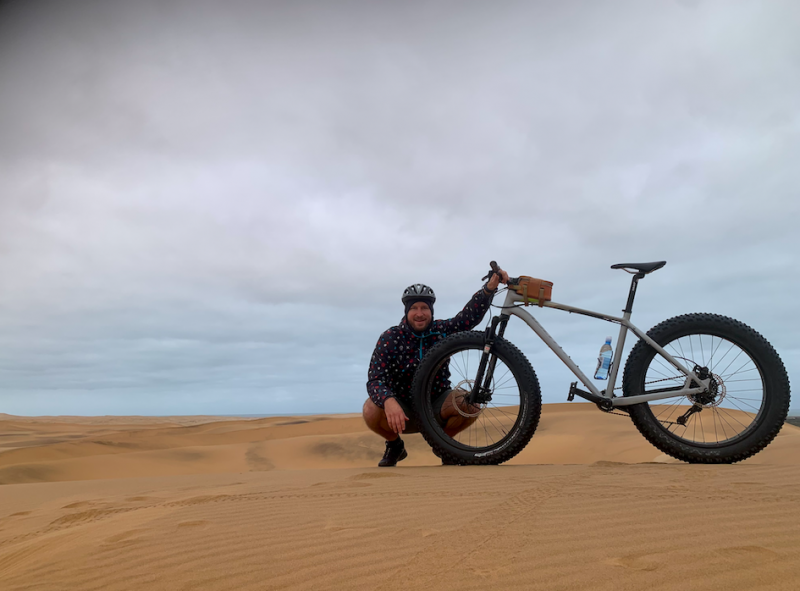
The vast and the glorious
I left the desert behind me and headed almost 500 km north. My next destination was the arid savannah of Etosha and the world famous Etosha Pan, a streak of white across the face of the Nambian bushveld, and so vast it is visible from space!
The landscape is, again, unique and very unusual, even for a seasoned bush visitor. Mainly because the landscape is almost entirely flat. The horizon blurring in the heat waves as land meets an impossibly blue sky 360 degrees around you. There is little water. The roads are straight and wide and seem to go on forever. Yet there is life! Life everywhere. You just need to tune in to it on its own frequency. Staying at Taleni Etosha Village, which is less than 3km from the Anderson Gate to the Park, I woke up each morning early to get in as the park opened at sunrise, with a lovely Slowtown Coffee French press.
The Etosha Pan is 4800km2 and over 100km wide at its widest point. There is nothing in the pan at all, and yet it covers 25% of the Etosha National park – underneath it water flows through ancient waterways and bubbles up as natural springs in strategic places. And this, ladies and gentlemen is where you find life! Thousands of springbok, zebra, wildebeest, ostrich and oryx thrive around the dusty edges of the water, making way only for the elephants who make the daily pilgrimage en masse and emerge from the shimmer of the horizon like a thunderous pachyderm parade, a truly impressive sight! Of course, the predators are never far away, as this abundant food source and the life-giving water supply endless opportunity for Lions, cheetah and jackal. I was lucky enough to see a number of big cats, in various family groupings at every waterhole, and at one particular spot, named Aus, saw 3 prides of Lion and 2 huge groups of elephant within half an hour of arriving!
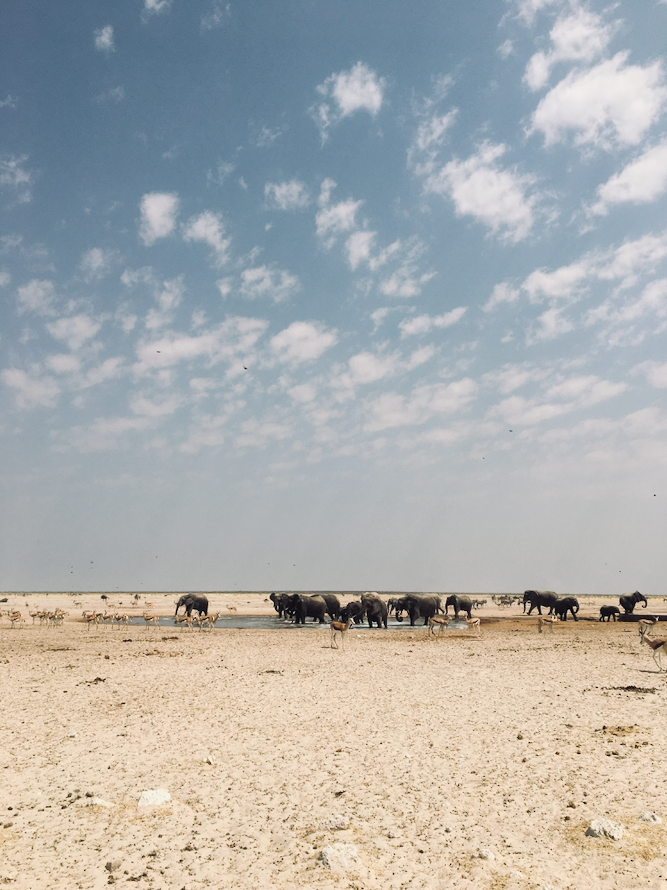
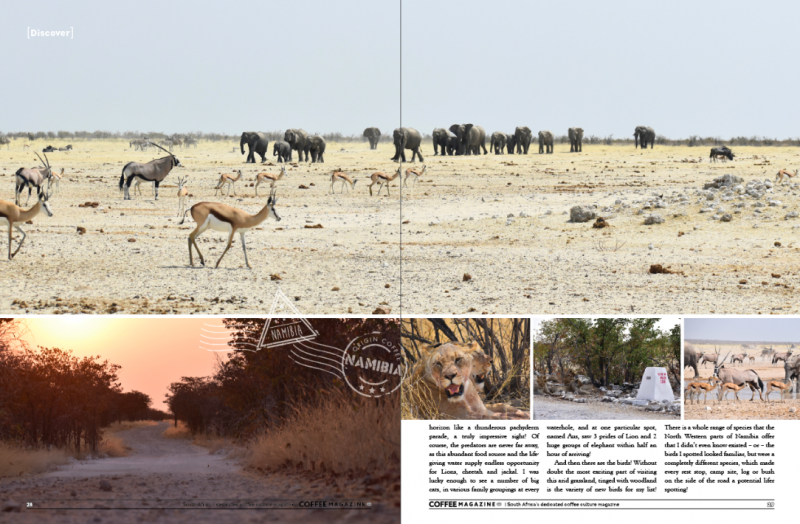
And then there are the birds! Without doubt the most exciting part of visiting this arid grassland, tinged with woodland is the variety of new birds for my list! There is a whole range of species that the North Western parts of Namibia offer that I didn’t even know existed – or – the birds I spotted looked familiar, but were a completely different species, which made every rest stop, camp site, log or bush on the side of the road a potential lifer spotting!
An unexpected gem
Finally, it was time to head south again, towards Windhoek and the homeward leg of the tour. My destination was 80Km north of the capital, situated in rocky, dry woodland area known as Midgard. An old Country estate, this little oasis reminds me of a cross between the Western Australian outback and the KwaZulu Natal Midlands. Birds are plentiful, eagles soar above the rocky outcrops surrounding the Estate and baboons roam freely amongst the grounds (and sometimes in your room if you leave a window open, like I did!)
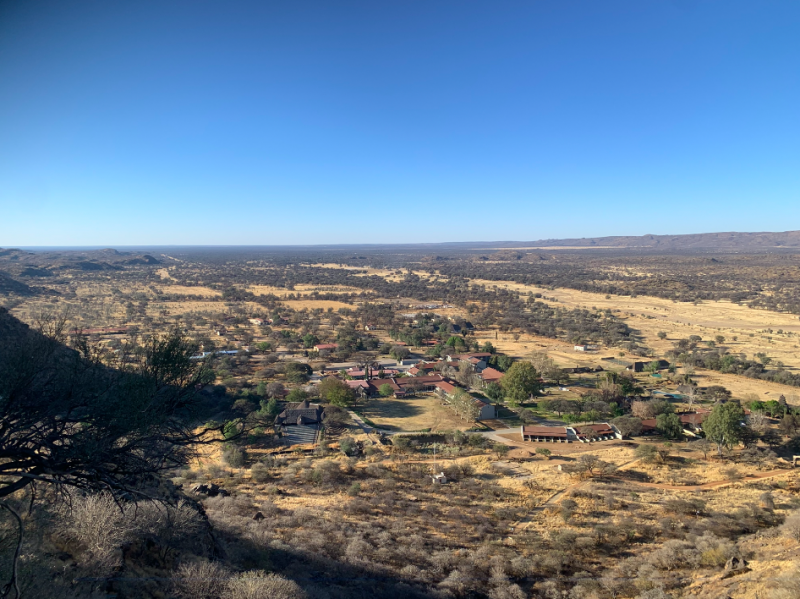
It is extremely hot and dry at this time of year, which meant that any water source attracted a lot of birds – a quick hike up the stony dirt path behind the estate and I found a natural spring, bubbling up, enclosed on all sides by indigenous trees. I sat and watch for at least half an hour as literally hundreds of birds passed through – the beautiful waxbills, the finches, rollers and even a parrot or two! Up above the Verreaux’s Eagle soared from its rocky home overlooking the estate.
While coffee brought me to Namibia, the landscape, the flora and the fauna will vividly stay with me. The desert leaves an indelible imprint on your senses, something deep and sacred. The vastness of the Etosha pan and surrounding bush give a you sense of unparalleled freedom and the abundance of life around Midgard, set amid a stillness found only in Namibia, leave me craving more and planning my next trip!
Thanks and acknowledgements:
Slowtown Coffee Roasters for organising the trip to Namibia – Thanks Dennis!
Swakopmund Fat Bike Tours - https://www.swakopfatbiketours.com/
Living Desert Tour - https://www.livingdesertnamibia.com/
O&L Leisure - Stand Hotels and Midgard Estate - www.ol-leisure.com Thanks to Patricia Pickering.
Taleni Africa, Etosha Village - Huge thanks to Karl Heinz Oosthuizen and Christelle du Toit – Oosthuizen www.taleni-africa.com
Namibia Bird and Animal list and *Lifer’s
Namib Desert
*Tractrac chat
Greater Flamingo
*Pied avocet
*Little stint
Black winged stilt
*White fronted plover
Etosha
Southern pale chanting goshawk
Crowned lapwing
Black shouldered kite
Fish Eagle
Green wood hoopoe
Black bellied bustard
Southern yellow billed Hornbill
Glossy starling
Steppe Buzzard
Lilac breasted roller
Double banded sandgrouse
Black backed jackal
Springbok
Steenbok
Kori bustard
Greater Kestrel
*Northern Black Korhaan
*Burchells Courser
Blacksmith lapwing
Spotted thick knee
Yellow mongoose
Giraffes
Zebra
Springbok
ELEPHANTS - Capital letters on purpose, there were SO MANY elephants
Lions, females and Cubs
Eland
*Namaqua dove
Lappet faced vulture
Red Haartebeest
White bellied sunbird
*Crimson breasted shrike
White browed scrubrobin
Ant eating chat pair
Marico flycatcher
Nile monitor lizards mating
Capped Wheatear
*Double banded courser
Plain backed pipit
Greybacked sparrow lark
Brown snake eagle
Black rhino
*Violet-eared waxbill
Lanner falcon With kill
Tree squirrel
Crimson breasted Shrike playing with squirrel
White backed vulture
*Purple roller
Red eyed bulbul
Chin spot batis
White crested helmet shrike
*Bare-cheeked babbler
Midgard
Lilac breasted roller
*Southern white crowned shrike
Groundscraper Thrush
African Hoopoe pair
Verreaux’s Eagle pair
Camaroptera
Scarlet chested sunbird
Burchell’s Starling
Blue waxbill
Violet eared waxbill male and female
Small dark pink body unidentifiable
Acacia pied barbet
White backed mouse bird
*Swallow tailed Bee-eater
Golden tailed woodpecker
Purple Roller
Red billed hornbill
African hornbill
*Ruppell’s Parrot
*Pale winged starling